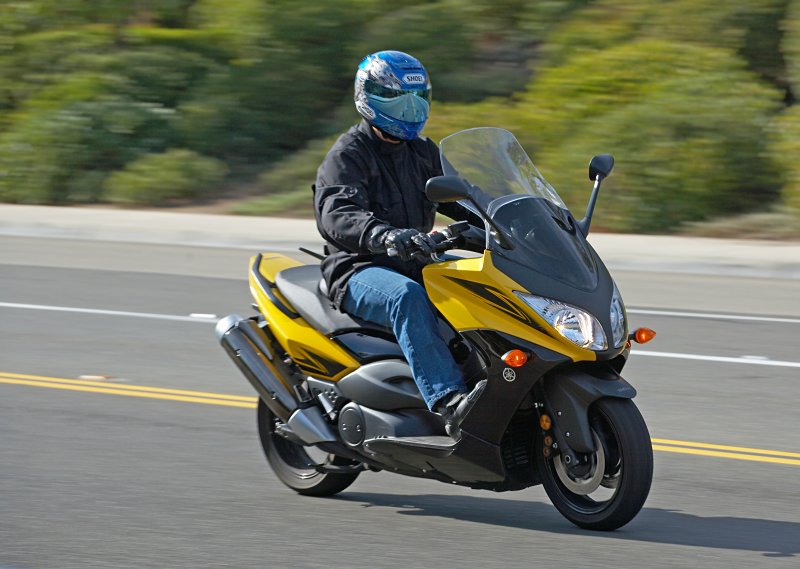
Scooters. Until a few years ago, scooters were something few serious motorcycle enthusiasts had much interest in. When we thought of them at all, the image that came to mind was usually that of an urban hipster scooting his way to the coffee shop aboard a Vespa, or possibly a pizza delivery boy buzzing through the urban landscape on a small, beat-up machine. But the combination of unpredictably fluctuating gas prices, and the recent release of numerous large-displacement, freeway-capable scooters is conspiring to change that opinion. In short, for many who rely on two wheels for transportation, scooters are edging closer and closer to becoming ‘cool’.
Of course, our two-wheeled brethren in Europe have long appreciated the utility of the scooter. Incredibly high gas prices, combined with the stringent tiered licensing programs in many European countries, have pushed scooters to the forefront of the European market. Take a walk through any city in Italy or Spain, and you’ll see hundreds of scooters, mostly 125s and 250s, buzzing rapidly through traffic, often at the hands of hip young urbanites. But as these scooter enthusiasts matured, demand rose for a sportier, more powerful and aggressive machine for them to upgrade to.
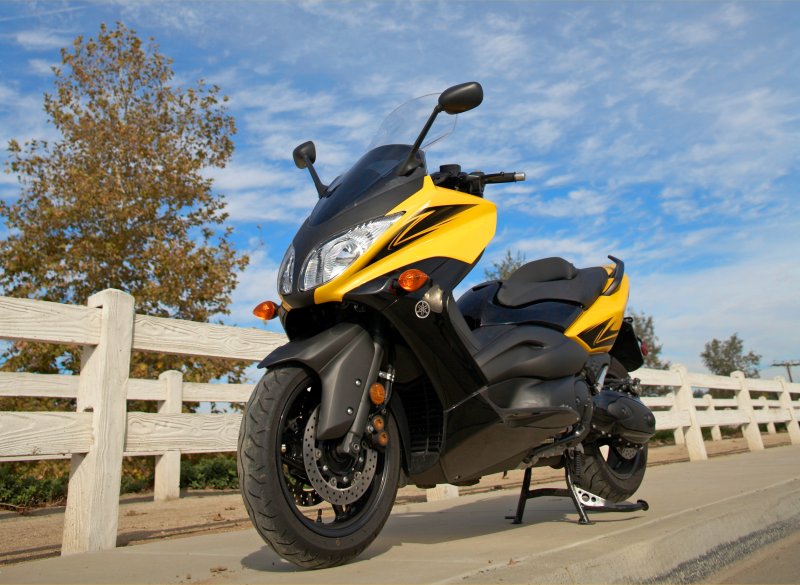
Yamaha satisfied that demand with their T-Max, which has been available in Europe for some time. My European friends tell me that all over France and Italy, the T-Max’s sporty handling and aggressive styling have made it an extremely popular choice for performance-oriented scooter enthusiasts. In fact, the European market already offers a whole host of performance modifications designed to make a customer’s T-Max stand out from (and pull away from) the bevy of identical machines found both in the cities, and the canyons.
That’s right, I said canyons. While sharp handling isn’t something most scooters are known for, the T-Max’s R1-sourced brakes and large (for it’s category) wheel/tire combo betray its aggressive intentions. Spend a little time on google, and you’ll find a host of European scooter forums where posters brag about hanging with 600cc sportbikes in the canyons. That might sound hard to believe, but after spending some time aboard the 2009 model, I’m convinced that it’s distinctly possible (rider skill levels being the crucial factor, of course).
The first thing that caught my eye when approaching the T-Max is it’s aggressive styling. With sharp-edged, minimalist (for a scooter) bodywork, it’s clear Yamaha’s designers intended to create a visual connection to the R-series sportbikes. The single upswept muffler, in two-tone black and silver, is also reminiscent of recent sportbike offerings from the tuning fork company.
Swing a leg over the T-Max, and its strikingly low center of gravity immediately makes itself known. Because it uses a CVT for power transmission, there is no clutch lever – the left lever controls the rear brake, similar to other scooters I’ve tested in the past.
Pulling away from a stop, two issues immediately make themselves known. At 5’8″ with a 30″ inseam, I found the T-Max’s tall seat high made it difficult to paddle along when making extremely low-speed maneuvers or when backing up. This difficulty was exacerbated by a somewhat abrupt clutch engagement (there is a clutch – it’s an automatically-operated centrifigul unit). This can make parking-lot speed maneuvers frustrating, with a tendency for the bike to lurch forward suddenly when the clutch engages.
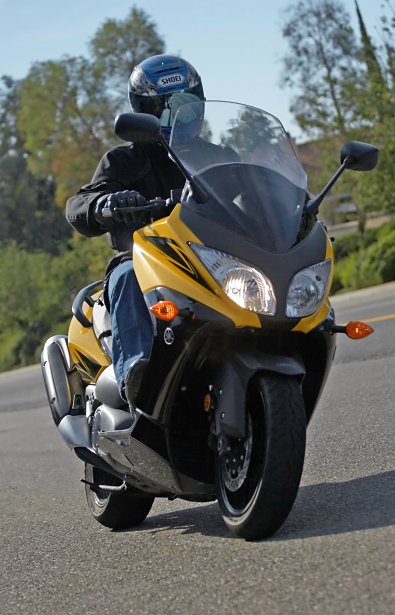
Once out on the open road, however, things change markedly for the better. The 499cc parallel twin, which features dual overhead cams and a reasonably high compression ratio of 11:1, is an impressive powerplant for the class, providing plenty of acceleration for both around-town and freeway riding. Jumping away from stoplights, I easily left average cars eating my dust, and the CVT helped keep the engine near its sweet spot so that acceleration was always available when I needed it. On the freeway, the T-Max accelerates with respectable rapidity up to a typical 80-mph cruising speed (remember, I live in California!). More is available if required, but acceleration past this point is slower and more deliberate. Nevertheless, I managed at one point to achieve an indicated 106mph, and for those who are only “kind of” in a hurry, cruising at 90mph is possible for long periods. At these speeds, however, you can distinctly feel the engine straining, and you won’t be surprised to find that fuel mileage figures fall dramatically (more on that later).
Aside from the slight abruptness of it’s initial engagement (which can also be irritating when exiting extremely slow-speed corners), the belt-driven CVT performs admirably during all types of riding. When cruising, it keeps the revs low for fuel efficiency, but when your right hand demands more power, the T-Max delivers. My commute consists of a long stretch of two-lane rural highway, and I’m ocassionally forced to pass slow-moving produce trucks and other rolling roadblocks. From a starting speed of 40-50mph, the T-Max responded rapidly to the throttle and completed these overtaking maneuvers quickly and safely. No one who’s grown used to the ridiculous power of modern sportbikes or sport-tourers would ever call it “fast”, but it’s definitely adequate for every situation I encountered, and can even jump from 70 to 80mph fairly rapidly during freeway riding. Let’s call it “quick”.
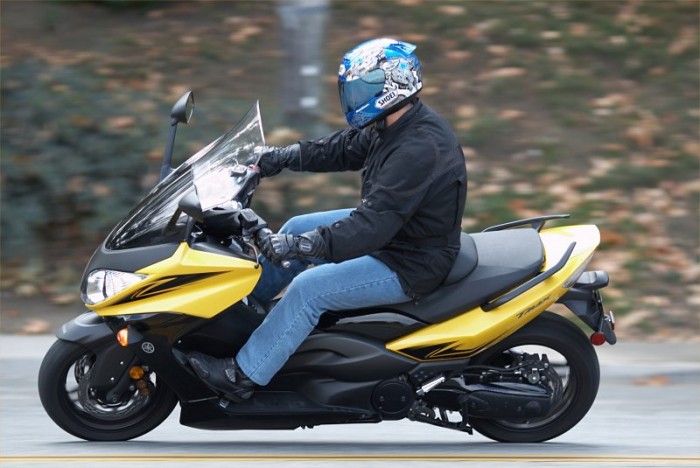
Not only is it quick, it’s also efficient. Riding aggressively, with heavy throttle use and 80-90mph cruising speeds on the freeway (don’t tell the CHP!), I saw mileage in the 40-45mpg range. Riders with a less aggressive throttle wrist could most likely get into the 50s, especially if they’re doing a lot of freeway cruising.
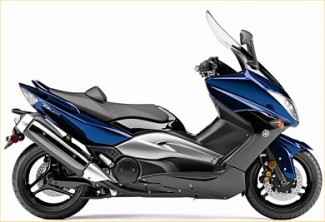 The motor may not break any records, but it’s in the handling department where the T-Max really shines. The combination of light weight (for its class) and a ridiculously low center of gravity make it easy to toss around in even the tightest corners. The T-Max somehow manages to offer the elusive combination of stability and responsiveness; I personally believe that the stability comes from the long wheelbase and the large, 15″ wheels, while the geometry of the die-cast aluminum frame provides the responsiveness. Front-end feel and mid-corner grip is aided by the large 43mm front forks, which are several millimeters bigger in diameter than those most competitors.
The motor may not break any records, but it’s in the handling department where the T-Max really shines. The combination of light weight (for its class) and a ridiculously low center of gravity make it easy to toss around in even the tightest corners. The T-Max somehow manages to offer the elusive combination of stability and responsiveness; I personally believe that the stability comes from the long wheelbase and the large, 15″ wheels, while the geometry of the die-cast aluminum frame provides the responsiveness. Front-end feel and mid-corner grip is aided by the large 43mm front forks, which are several millimeters bigger in diameter than those most competitors.
Braking is the T-Max’s real strong suit, however. The twin 267mm discs up front are gripped by a beautiful pair of four-piston monoblock calipers that look to be straight out of Yamaha’s sportbike parts bin – a few years old, to be sure, but still far more powerful than anything you’d expect to see on a humble scooter.
The powerful brakes are assisted by the aforementioned low CoG – even under extremely hard braking, the T-Max stays incredibly level, with the front end diving barely at all. This means that you can steer even while braking hard without the twitchiness that comes from severe front-end dive – a very useful safety feature, and a fun one to use in the canyons (hey, I just passed that 600 on the brakes!).
For a real-world example of the T-Max’s handling prowess, consider this – I spent a day chasing MD contributor Barry Winfield through the tight, twisty canyons of Malibu, California, and the T-Max held its own quite admirably. Barry was mounted on an Aprilia Mana, and while he wasn’t pushing the limits, he’s an extremely experienced rider, and his ‘moderate’ pace would leave many riders in the dust. While the T-Max’s 499cc twin couldn’t match the Mana’s larger powerplant for corner-exit acceleration, I was able to maintain comparable corner speeds, and if anything, the T-Max could brake later and harder. My only complaint was that the T-Max seemed to have a slight difficulty finishing corners – the front end wants to ‘push’ a bit on corner exit, likely a consequence of the extremely long wheelbase. Not a huge issue, but it does delay how early you can get on the power coming out of a tight turn.
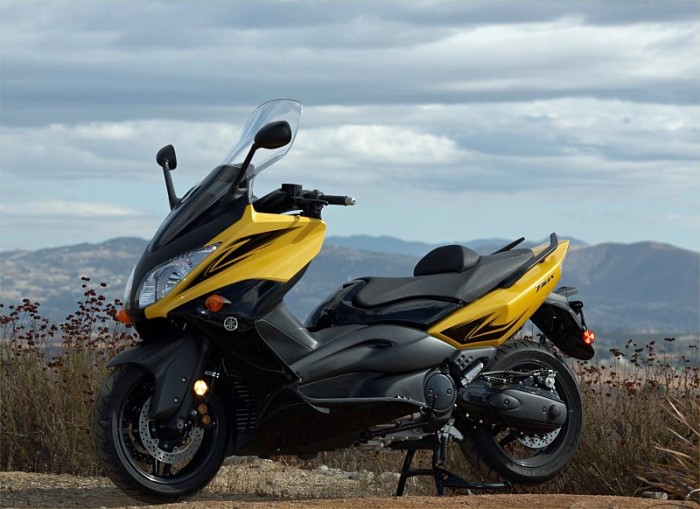
The stability of the T-Max was beneficial at other times, as well. We’ve had some unusually cold nights here in SoCal lately, and every rider knows how slippery paint strips can be on a cold, misty night. Several times, turning out from a side road near my home onto a busy thoroughfare that required hard acceleration to merge safely, I slid both the front and rear wheels of the T-Max on a pesky paint stripe that was put in just the wrong place for motorcyclists. Leaned over and on the gas, the T-Max recovered from these slides with beautiful composure, not even causing an increase in rider heart rate. This is not to say that I recommend drifting your T-Max like Casey Stoner at a tire test, but its a testament to the bike’s composure even at the very limit of its handling capabilities.
Unfortunately, there are a few problems with the T-Max design that hold it back from real greatness. The first, and most annoying, is the design of the windscreen. As I said earlier, I’m 5’8″, and when I sat up straight on the T-Max, the wind buffeting thrown off the top edge of the T-Max’s screen was at just the right height to cause a severely annoying level of buffeting and noise around my helmet. This tended to encourage me to slouch, which exacerbated another noteable problem – the non-adjustable backrest isn’t all that useful. For my size (and the length of my legs), it’s too far back to offer any support when sitting in what I found to be the natural position on the seat, and it can’t be adjusted forward like the backrests of some other scooters I’ve tested. And while I’m discussing the backrest, I’d like to suggest that Yamaha’s engineers make the next generation not only adjustable, but somewhat taller – I’d like it to support my low back, not just my butt. Both these changes would contribute greatly to the T-Max’s already impressive long-distance comfort.
The trunk, unfortunately, is not quite as spacious as those of some competitors. It will take a full-face helmet, but that’s about it. While transporting photography equipment on my way to shoot photos for some other MD articles, I often wished for more space. However, this is most likely a consequence of the frame and engine design that allows the T-Max to have such a low center of gravity, so I won’t complain too much.

Despite these flaws, I thoroughly enjoyed the approximately 1200 miles I spent aboard the new T-Max. With a reasonably powerful motor, sharp handling, and the utility of a step-through, automatic-transmission scooter, the T-Max could be the ideal machine for someone who needs an efficient commuter but wants to have some fun in the twisties on the weekends. After a few rides, you’ll understand exactly why this bike is so popular in Europe.





